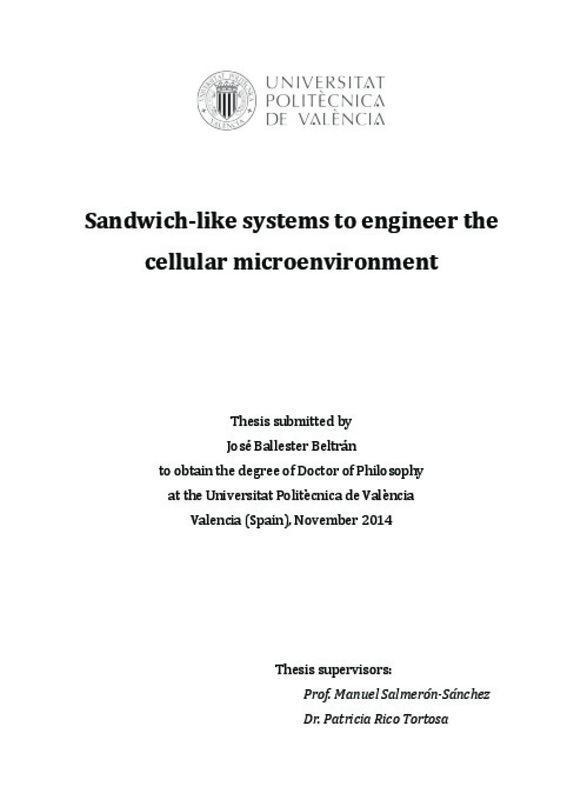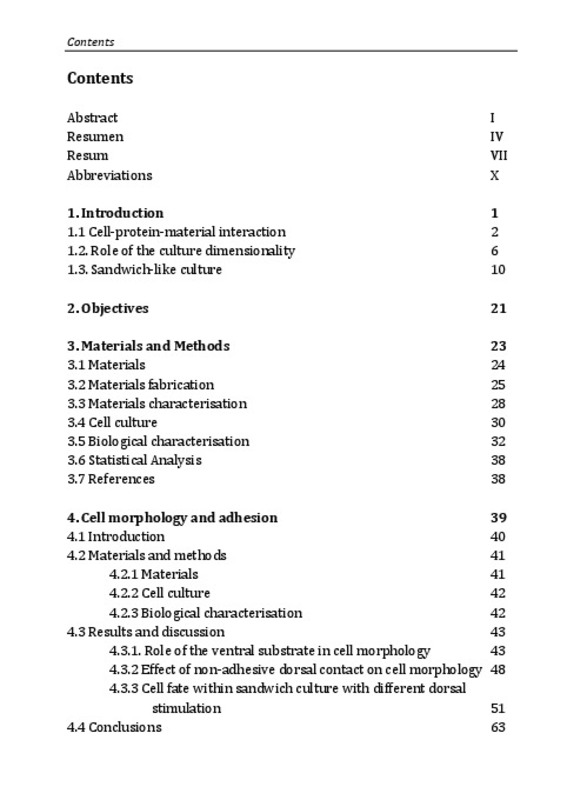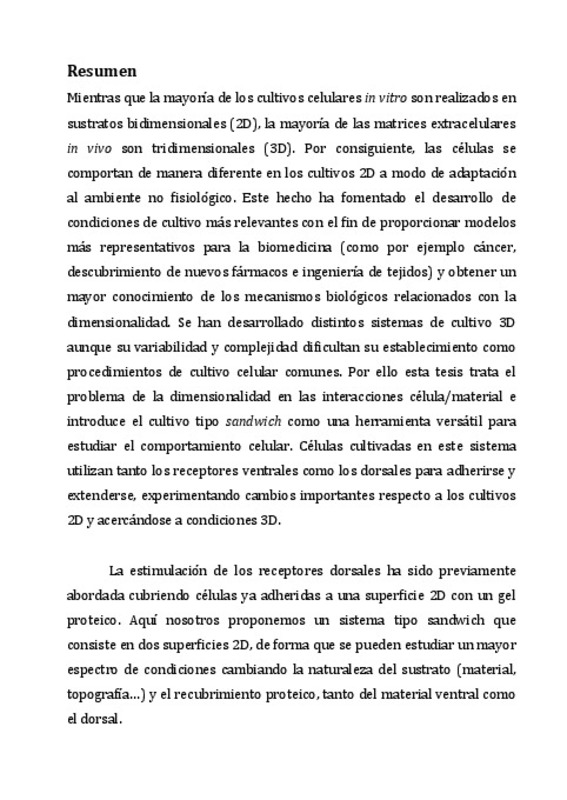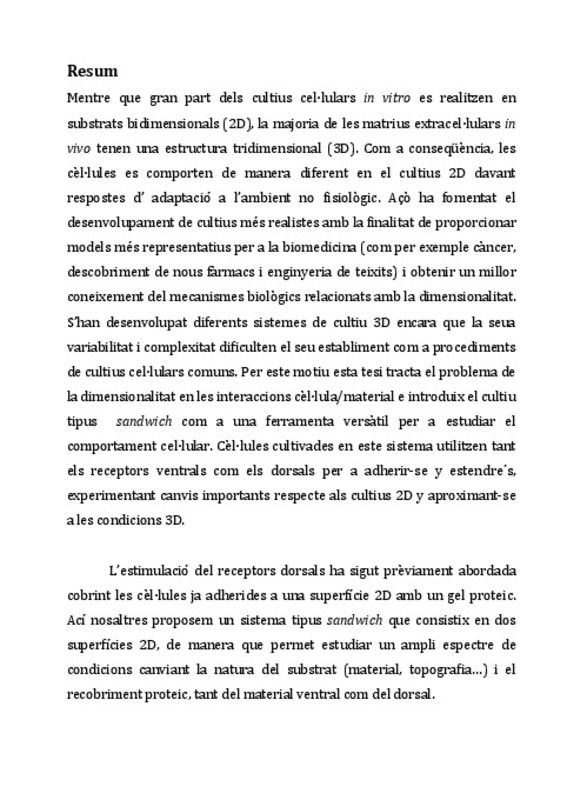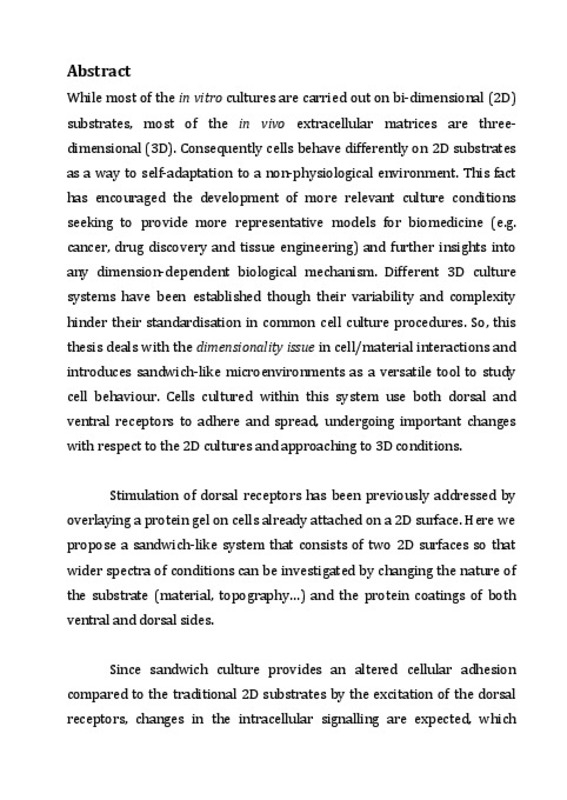- RiuNet repositorio UPV
- :
- Investigación
- :
- Tesis doctorales
- :
- Ver ítem
JavaScript is disabled for your browser. Some features of this site may not work without it.
Buscar en RiuNet
Listar
Mi cuenta
Estadísticas
Ayuda RiuNet
Admin. UPV
Sandwich-like systems to engineer the cellular microenvironment
Mostrar el registro sencillo del ítem
Ficheros en el ítem
| dc.contributor.advisor | Rico Tortosa, Patricia María
|
es_ES |
| dc.contributor.advisor | Salmerón Sánchez, Manuel
|
es_ES |
| dc.contributor.author | Ballester Beltrán, José
|
es_ES |
| dc.date.accessioned | 2015-03-20T13:53:26Z | |
| dc.date.available | 2015-03-20T13:53:26Z | |
| dc.date.created | 2014-11-14 | es_ES |
| dc.date.issued | 2015-03-20 | es_ES |
| dc.identifier.uri | http://hdl.handle.net/10251/48166 | |
| dc.description.abstract | Abstract While most of the in vitro cultures are carried out on bi-dimensional (2D) substrates, most of the in vivo extracellular matrices are threedimensional (3D). Consequently cells behave differently on 2D substrates as a way to self-adaptation to a non-physiological environment. This fact has encouraged the development of more relevant culture conditions seeking to provide more representative models for biomedicine (e.g. cancer, drug discovery and tissue engineering) and further insights into any dimension-dependent biological mechanism. Different 3D culture systems have been established though their variability and complexity hinder their standardisation in common cell culture procedures. So, this thesis deals with the dimensionality issue in cell/material interactions and introduces sandwich-like microenvironments as a versatile tool to study cell behaviour. Cells cultured within this system use both dorsal and ventral receptors to adhere and spread, undergoing important changes with respect to the 2D cultures and approaching to 3D conditions. Stimulation of dorsal receptors has been previously addressed by overlaying a protein gel on cells already attached on a 2D surface. Here we propose a sandwich-like system that consists of two 2D surfaces so that wider spectra of conditions can be investigated by changing the nature of the substrate (material, topography…) and the protein coatings of both ventral and dorsal sides. Since sandwich culture provides an altered cellular adhesion compared to the traditional 2D substrates by the excitation of the dorsal receptors, changes in the intracellular signalling are expected, which might alter important processes such as proliferation, morphology, migration and differentiation. Hence this thesis evaluates the effect of different sandwich culture parameters in cell behaviour. First, cell fate upon adhesion was evaluated in terms of morphology, proliferation and adhesion. Different conditions were studied such as materials with different properties or protein coatings (dorsal and ventral substrates), as well as the effect of sandwiching cells just after seeding or after been allowed to adhere to the ventral substrate. Interesting results were obtained such as the relationship between the ability of cells to reorganise the ECM with cell morphology, proliferation and adhesion, similarly as observed in 3D hydrogels (degradable vs nondegradable systems). Then, cell migration within sandwich culture was studied by live imaging of a wound healing assay. Results revealed the key effect of both ventral and dorsal substrates in determining the migration rate as well as the migration mode used by cells. Moreover cells within the sandwich culture migrating in the wound healing assay adopted an elongated cell morphology that resembled cells migrating in other 3D systems. Beyond differences in cell morphology and migration, dorsal stimulation promoted cell remodelling of the extra-cellular matrix (ECM) over simple ventral receptor activation in traditional 2D cultures. Finally the effect of sandwich culture on cell differentiation was evaluated. First we showed an increase in C2C12 myogenic differentiation when cultured within the sandwich system. This enhancement was shown to be dorsal stimulation dependent and related to an alteration of the signalling pathway and the growth factor release. To determine if sandwich culture leads only to myogenic differentiation or whether it allows differentiation to other lineages, 4 different human mesenchymal stem cells (hMSCs) lines were cultured under the same conditions. Results showed the same sandwich environment triggered different cell differentiation. This points out the importance of the microenvironment cell niche in vivo, which highly influence cell fate, and thus the need of mimicking it properly in vitro. Overall, sandwich-like microenvironments switch cell behaviour towards 3D-like patterns, demonstrating the importance of this versatile, simple and robust approach to mimic cell microenvironments in vivo. | en_EN |
| dc.language | Inglés | es_ES |
| dc.publisher | Universitat Politècnica de València | es_ES |
| dc.rights | Reserva de todos los derechos | es_ES |
| dc.subject | Sandwich culture | es_ES |
| dc.subject | 3D culture | es_ES |
| dc.subject | 3D matrix adhesion | es_ES |
| dc.subject | Fibronectin | es_ES |
| dc.subject | Integrins | es_ES |
| dc.subject | Cell migration | es_ES |
| dc.subject | Cell differentiation | es_ES |
| dc.subject | Cell morphology | es_ES |
| dc.subject | Mesenchymal stem cells | es_ES |
| dc.subject.classification | FISICA APLICADA | es_ES |
| dc.title | Sandwich-like systems to engineer the cellular microenvironment | es_ES |
| dc.type | Tesis doctoral | es_ES |
| dc.identifier.doi | 10.4995/Thesis/10251/48166 | es_ES |
| dc.rights.accessRights | Abierto | es_ES |
| dc.contributor.affiliation | Universitat Politècnica de València. Departamento de Biotecnología - Departament de Biotecnologia | es_ES |
| dc.description.bibliographicCitation | Ballester Beltrán, J. (2014). Sandwich-like systems to engineer the cellular microenvironment [Tesis doctoral no publicada]. Universitat Politècnica de València. https://doi.org/10.4995/Thesis/10251/48166 | es_ES |
| dc.description.accrualMethod | TESIS | es_ES |
| dc.type.version | info:eu-repo/semantics/acceptedVersion | es_ES |
| dc.relation.pasarela | TESIS\8028 | es_ES |
Este ítem aparece en la(s) siguiente(s) colección(ones)
-
Tesis doctorales [5286]






